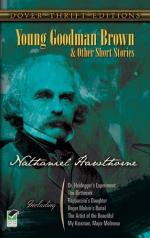|
This section contains 1,651 words (approx. 6 pages at 300 words per page) |

|
SOURCE: “Romanticism's Fallen Edens: The Malignant Contribution of Hawthorne's Literary Landscapes,” in College Language Association Journal, Vol. 42, No. 3, 1999, pp. 353-63.
In the following essay, Johanyak explores Hawthorne's use of the forest in “Young Goodman Brown” and several of his other works, contending that Brown's sojourn in the forest serves to remind him that “we are everywhere surrounded by evil.”
America's stern puritannical history provided nineteenth century writers with ideal plots and settings for the age-old conflict between good and evil. Edenic gardens and pastoral woodlands grace countless works of the Romantic era, wherein Adam- and Eve-like lovers succumb to temptation and find themselves not only cast out of their normative societies, but often torn from each other as well—whether spiritually, emotionally, or literally. Significantly, the forest settings of these tales contribute substantially and malignantly to the plot development of such stories.
None used the Edenic motif so...
|
This section contains 1,651 words (approx. 6 pages at 300 words per page) |

|


